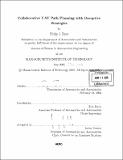Collaborative UAV path planning with deceptive strategies
Author(s)
Root, Philip J
DownloadFull printable version (9.435Mb)
Alternative title
Collaborative Unmanned Aerial Vehicles path planning with deceptive strategies
Other Contributors
Massachusetts Institute of Technology. Dept. of Aeronautics and Astronautics.
Advisor
Eric Feron.
Terms of use
Metadata
Show full item recordAbstract
In this thesis, we propose a strategy for a team of Unmanned Aerial Vehicles (UAVs) to perform reconnaissance of an intended route while operating within aural and visual detection range of threat forces. The advent of Small UAVSs (SUAVs) has fundamentally changed the interaction between the observer and the observed. SUAVs fly at much lower altitudes than their predecessors, and the threat can detect the reconnaissance and react to it. This dynamic between the reconnaissance vehicles and the threat observers requires that we view this scenario within a game theoretic framework. We begin by proposing two discrete optimization techniques, a recursive algorithm and a Mixed Integer Linear Programming (MILP) model, that seek a unique optimal trajectory for a team of SUAVs or agents for a given environment. We then develop a set of heuristics governing the agents' optimal strategy or policy within the formalized game, and we use these heuristics to produce a randomized algorithm that outputs a set of waypoints for each vehicle. Finally, we apply this final algorithm to a team of autonomous rotorcraft to demonstrate that our approach operates flawlessly in real-time environments.
Description
Thesis (S.M.)--Massachusetts Institute of Technology, Dept. of Aeronautics and Astronautics, 2005. Includes bibliographical references (p. 87-89).
Date issued
2005Department
Massachusetts Institute of Technology. Department of Aeronautics and AstronauticsPublisher
Massachusetts Institute of Technology
Keywords
Aeronautics and Astronautics.